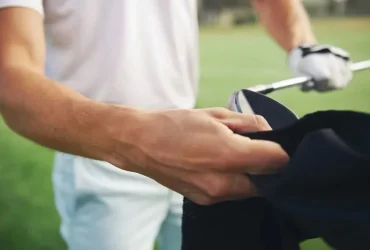How to Grip a Putter – 6 Different Ways to Hold a Putter
Golf is a game won and lost on the putting green. Which is why in the following article I’m going to share with you the best options on how to hold a putter.
Okay, so you’re struggling with your putter? You struggle with your consistency? One minute you can hole an 8 footer, the next you miss a simple putt in the 3ft range, your putting consistency is all over the place. More often than not, you can improve your consistency by simply working on a proper putting grip.
By improving the way you’re gripping your putter, you’ll be able to control your putter head more effectively and become more consistent on the greens.
Contents
How To Grip A Putter – What You Should Do!
In the majority of cases when a golfer is having problems with their putting, it tends to relate to how they grip their putter. A grip you use for your tee shot, or your iron play, should not be anything like how you hold the putter. When hitting a drive off the tee you hold the club with your fingers, allowing free motion of the wrists to generate power. When you’re putting, the wrists should not be involved at all, they should remain neutral throughout your putts.
Instead of gripping the club in the fingers, like you would a driver, move the putter grip up into the palm of your hands, so that the top of the putter grip is above the hinge of your wrists. This hinders any movement in the wrists and allows you to play a much smoother consistent stroke. If you’re gripping the putter correctly, it should feel like an extension of your forearms. In contrast, if you grip your driver as if you’re ready to tee off, you’ll get the feeling that the club is an extension of the wrists.
To help picture what this grip should look like, I have included two pictures below.
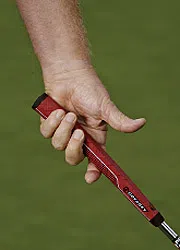
Got a grip? Don’t miss these tips:
Proper Golf Grip: How to Hold a Golf Club
6 Tips on How to Grip a Golf Club Correctly
Strong, Neutral, or Weak? The Best Golf Grip!
Different Putting Grips You Can Try
There are several ways of how to hold a putter. Just watch the pros, you’ll see tons of methods.
Overlap Putting Grip
Used by the vast majority of golfers today for all golf clubs, the overlap is the most popular with players on tour and is used by many beginners. It provides feel yet reduces the flexibility of the wrists, and hence reduces the risk of hinging the wrists and pulling a putt. The one flaw with this type of putting grip though, is the fact you can become a little too handsy, resulting in a mistimed putting stroke.
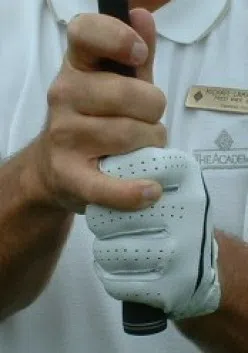
Interlock Grip
The interlock grip is another popular technique. Similar to the overlap, in the fact the pinky leads over the left hand (right for lefties), in this case however, the pinky crosses over with your index finger. This type of grip produces increased feel with the putter, which is particular useful on inconsistent greens . In my experience, the benefits of both the interlock and the overlap are the same. Choosing between the two just comes down the personal preference, and which feels most comfortable.
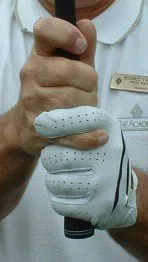
Left Hand Low Putting Grip
The left hand putting grip (or cross handed grip as it’s sometimes known) has been seen being used by pro’s since the 90’s. Vijay Singh noticeably used this grip during his win in the Masters in 2000, and has since adapted it include a touch of the claw putting grip (below). Dave Pelz recommended this grip in a recent article, it was recommended for putts within 12ft. I have to say this grip does produce stability and consistency in the putting stroke, but you do lose the feel. I wouldn’t recommend this type of grip on longer putts on slow inconsistent greens. Instead, if you were to use this particular grip I’d use it for straightforward putts within 5-8ft.
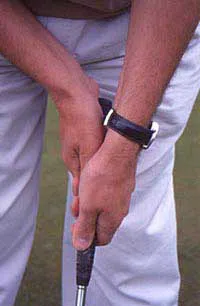
Reverse Overlap Putting Grip
This is exactly what it says, the exact opposite of the overlap grip. In the reverse overlap, instead of placing your pinky over your left hand, your index finger is placed over your right hand. It’s a small variation yes, but it produce a completely different feel. Many golfers prefer the feel they get form this over the standard overlap grip.
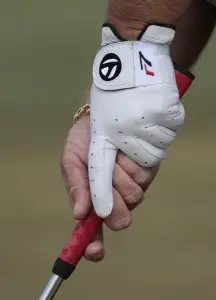
Baseball Putting Grip
This grip, also known as the ten finger grip, is the oldest style of grip, used when golf was in its infancy. Golfers used this type of grip to improve their feel on the greens. However, it’s not used much today because of the inconsistencies it can promote in your stroke.

The Claw Putting Grip
Used more and more in the last decade or so, the claw grip has grown in popularity with the pro’s. The are many variations of the claw, some of the more popular variations are pictured below. Its aim is to take most of the movement out of the wrists, promoting more consistency in the putting stroke. It takes a lot of the feel out of the putt but produces the most consistent putting stroke you’re likely to get (without using a belly putter).
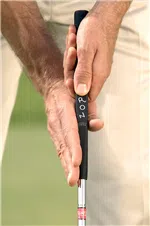
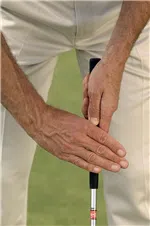
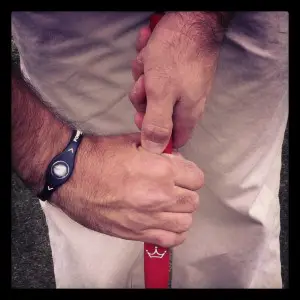
What Should You Take from All This?
Every golfer is different and to recommend one putting stroke to all would be foolish. However, as you’re more than likely a beginner, I would go with a simple overlap grip to start off with until you begin to get a feel of your putting. Once you start to get more confident in reading greens and distances, you can start to experiment. How to grip a putter is not always straightforward but always follow the basics.
Your putting grip can also change during a round, remember that. If the situation is the right one to use a putting grip that promotes consistency, then use that. If you have a long winding 15ft putt, then the situation may call for an overlap grip.
The most important thing to remember, is to use a putting grip that suits you the most. Good luck with your choices, and may you never 3 putt again!
Be sure to check out my article on how to choose the right putter length and my recent article on lag putting. If you’re in the market for a new putter then the Odyssey White Ice 2.0 is a putter I’d recommend or you could check out our best putters for beginners and high handicappers article, it’s full of great tips!


